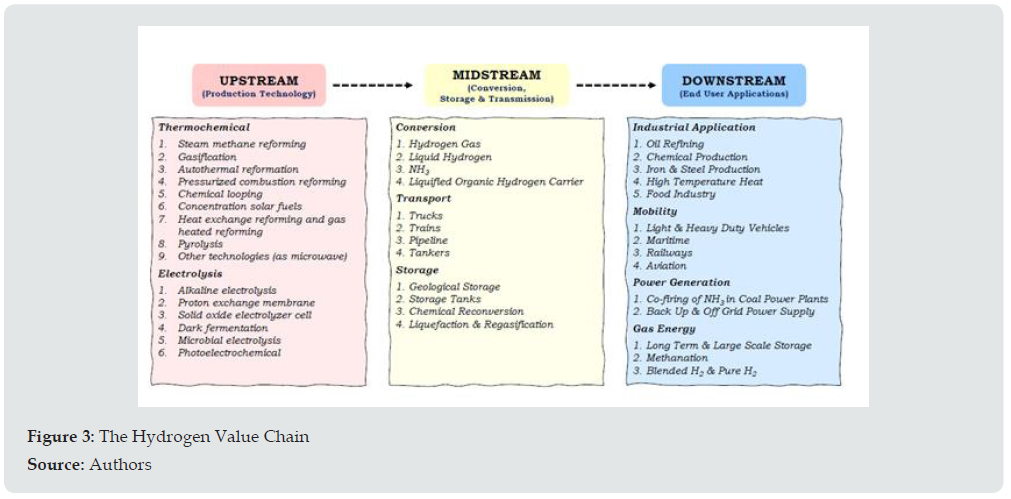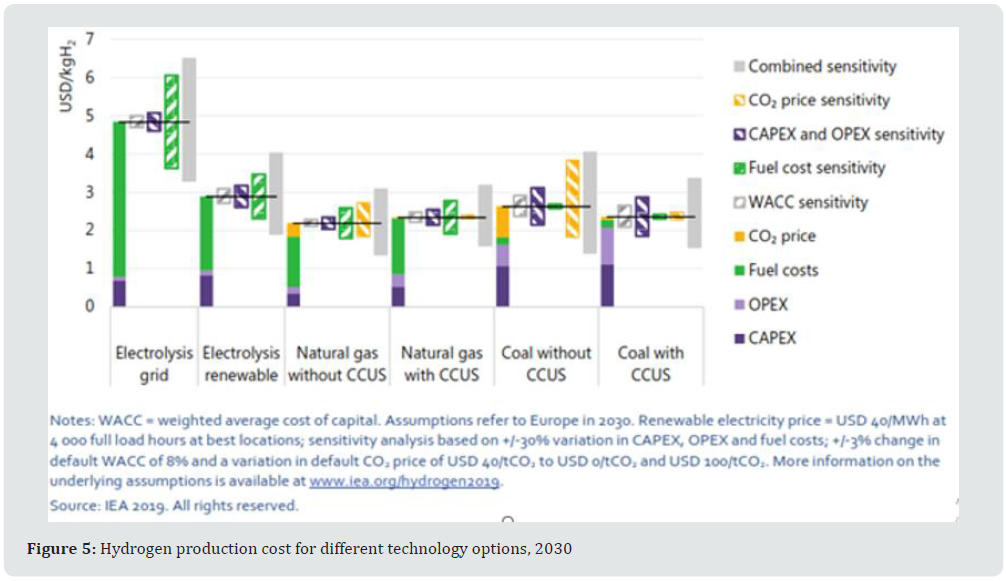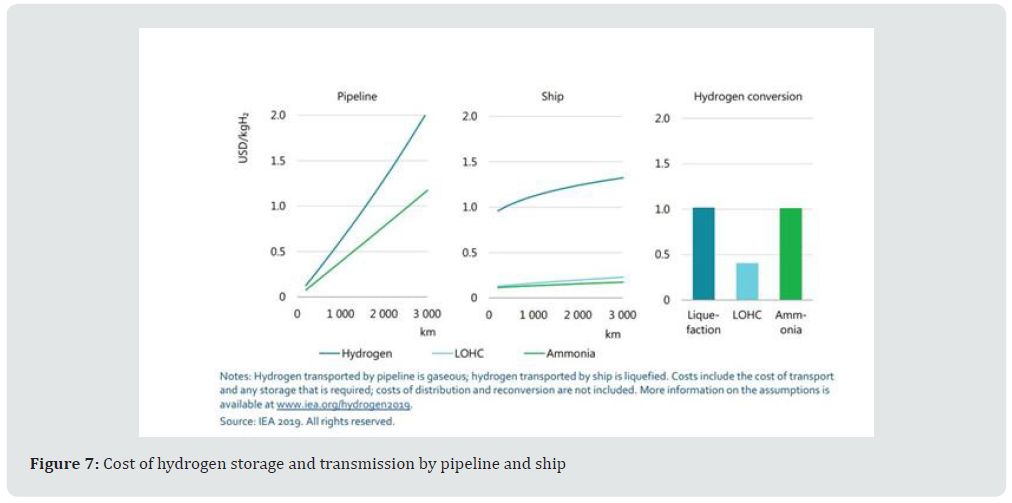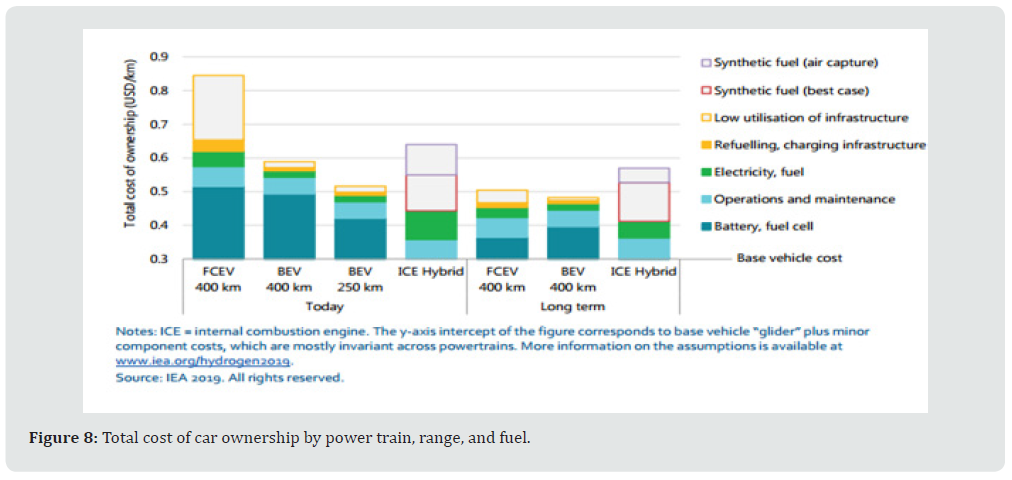
Lupine Publishers Group
Lupine Publishers
Menu
Research ArticleOpen Access 
Hydrogen as a Fuel: An Applied Perspective Volume 1 - Issue 5
Hardik Patel1, Sudhir Yadav2 and Pramod Paliwal3*
- 1Alumnus of School of Petroleum Management, Pandit Deendayal Energy University, India
- 2Professor at School of Petroleum Management, Pandit Deendayal Energy University, India
- 3Professor at School of Petroleum Management, Pandit Deendayal Energy University, India
Received: April 25, 2022 Published: May 5,2022
Corresponding author: Pramod Paliwal, Professor at School of Petroleum Management, Pandit Deendayal Energy University, India
DOI: 10.32474/JBRS.2022.01.000121
Abstract
Hydrogen as a fuel can be used to tackle various energy challenges. It provides a number of ways to decarbonize various sectors like transport, chemical, steel industry, etc. This paper aims to assess the potential of hydrogen to serve as an economically viable fuel alternative to fossil fuels. Hydrogen’s physical properties play an important role to assess its potential and its advantages and disadvantages as fuel in hydrogen combustion and fuel cell propulsion systems. It has become global agenda to find a sustainable fuel as the greenhouse gas emission are increasing which in turn enhance environmental concern and the whole world is in search of environmentally friendly energy option. Hydrogen is similar to electricity which can be considered a versatile energy carrier that can be produced from various primary energy sources including coal, biomass, natural gas, energy crops, sunlight, waste, wind, and nuclear power. This paper also discusses various challenges in terms of storage, transmission, and distribution of Hydrogen.
Keywords: Hydrogen Energy; Clean Fuel; Ghg Emission; Fuel Cell; Climate Change
Introduction & Context-Setting
Hydrogen was used as a fuel in the internal combustion engine first time over 200 years ago. It has become an integral part of the energy industry since the 20th century when the use of hydrogen became common in oil refining. There are various domestic resources from which we can produce hydrogen. Two attributes that have contributed to the use of hydrogen for clean energy are:
i) It can be used without direct emission of air pollutants for greenhouse gases
ii) It can be made from a wide range of low carbon energy sources. Its potential supply may be from renewable energy sources, biomass, and nuclear. It is possible to use CCUS (carbon capture, use, and storage) technology to produce low carbon fossil fuels and emissions during fossil fuel extraction. In short, hydrogen can contribute to a sustainable energy future in two ways:
a) Existing applications where hydrogen is used as a fuel can use hydrogen which is produced from cleaner production methods and various sources of energy.
b) Various new applications where hydrogen can be utilized as an alternative to existing fuels. It can be used in transport, heating, steel production, and electricity [1]. Further hydrogen can be used in its pure form, or it can be converted to fuels including synthetic methane, ammonia, and methanol. While Figure 1 explains why Hydrogen is termed the next-generation energy source, Table 1 shows the use of Hydrogen as a transportation fuel.
Source: https://www.csustan.edu/sites/default/files/honors/documents/journals/Stirrings/Chamoussis.pdf
This paper also cites the current literature related to Hydrogen as a fuel. The data has been collected from newspapers, websites, reports, research papers, and journals. Based on the available information from secondary sources, this study aims to understand the viability of hydrogen as a fuel for the future, and hence the paper is of the applied genre. The paper discusses Hydrogen production methods, storage, transport & distribution of Hydrogen, and Hydrogen usage in buildings, transport, and power. After the introduction and context setting including citing current literature in section 1, section 2 discusses Hydrogen production methods, section 3 discusses the Storage, Transmission, and Distribution of Hydrogen, and section 4 highlights Hydrogen usage in buildings, transport, and power. The discussion and conclusion are in Section 5.
Global Strategy Institute (2005) states that possible various sources of energy for transportation embrace element, electricity, and grain alcohol. It conjointly states that a $50-$200 billion quantity of investment amount is necessary over a ten to twentyyear to bring element cell vehicles into production, in line with Shell. As per America Energy Department, it needed to cut back value 3-5 times to create the element a viable fuel. Hydrogen as a future fuel also has to be contextualized with the aspects of decarbonization as a process towards the goal of a net-zero economy. The term decarbonization literally means carbon- reduction. The conversion to an economic system that decreases and compensates carbon dioxide (CO2) emissions in a sustainable manner is precisely what is envisioned. The long-term goal is to achieve a worldwide economy that is CO2-free. Hydrogen plays an important role here. Figure 2 discusses the key challenges to decarbonization and how Hydrogen addresses all these [2].
Ministerial Council on Renewable energy (2017) states that like fossil fuels, the element will be handled as fuel cell technologies that expeditiously generate electricity and warmth from element will be combined with element to ultimately cut back carbon in numerous areas together with power generation, transportation, industrial processes, and warmth use. Promising approaches to cut back the value of element embrace combining overseas unused energy with CCS and procuring huge amounts of the element from low-cost renewable energy. National Renewable Energy Laboratory (2016) provides data regarding the economic aggressiveness of element system configuration. Element technologies provide distinctive system flexibility which will modify interactions between multiple energy applications together with electricity, transportation, heating fuel, and industrial processes. Previous analysis established that element technologies, and particularly electrolyzes, will respond quickly enough and for spare length to participate in electricity markets. To date, there has been very little work done to assess the potential measure of electricity market participation for element systems. Ministry of New associated Renewable energy (2016) report states that element is an energy carrier (a secondary supply of energy) and is obtainable with chemicals combined forms in water, fossil fuels, biomass, etc. It will be liberated with the electrical or heat input (generated from some primary energy supply like fuel, atomic energy, or a renewable energy supply like - star, wind, electricity, etc.). Presently the agriculture sector is the largest user of element (as gas fertilizer), with forty-ninth of element being employed for ammonia production (Konieczny et al., 2008).
Upcoming element application sector victimization fuel cells because the principle energy device has given a replacement dimension to the complete element worth chain. The element production/consumption pattern or the demand/offer cycle for all applications apart from vehicles and power generation had ne’er witnessed any comparison with the fossil fuel-based worth chain as a result of their divergence and indirect linkage. However, with the gamut of opportunities rising because of the associated economic viability of hydrogen-based cell systems for transport applications, the direct comparison of element worth chain with the fuel primarily based energy system is inevitable. Chamousis (n.d.) states that the infrastructure for an element economy can accompany high capital prices. The transport of element through underground pipes looks to be the foremost economical once demand grows enough to want an outsized centralized facility. However, in places of low population density, this methodology might not be economically possible. The project mentioned earlier could become an associate possibility for people to supply their own element gas reception, with star panels lining their roof. A forceful amendment is required to prevent the results of our fuel-dependent society. As seen from the European Commission (2020) study, element prices delivered to the tip user can usually be considerably more than the prices of current fuel choices once fuel excise duty (e.g., energy tax, added tax) is excluded. However, element in some cases (e.g., vaporized element created by massive scale reforming of natural gas) may well be delivered nowadays at a price excluding fuel duty that will be such as, or cheaper than, liquid fuel prices together with fuel duty, permitting scope for introducing business incentives.
Argonne National Laboratory (2018) studies regarding value advantages analysis of technology improvement in lightweight duty cell vehicles. Advanced vehicle technologies can enable a discount of up to forty-first in cell power and up to five hundredths in H2 storage. Cell vehicles might reach life cycle value ($/mile) parity with typical vehicles by 2020 and with PHEVs by 2025. B. Gnörich (2012) studies regarding comparative life-cycle analysis of element cell vehicles. The rising variety of cell vehicles conferred in recent years underlines the idea that cell technology is well in check in the mobile application. However, market readiness may be an utterly totally different story because of the high prices of element tanks, electrical machines, and cell systems. Infrastructure issues conjointly persist and want to be self-addressed. Greg Frenette, and Daniel Forthoffer (2009) state that the magnitude of the technological, economic, and different challenges create element as cell outlook unlikely. However, Ford Motors believe that cell vehicles can become economically viable, and a very important contributor to the resolution of worldwide warming and air quality problems. Kaveh Mazloomi, and Chandima Gomes (2012) discuss that the element is a key player in storing energy that’s wasted at the generation stage in large-scale power grids by off-peak diversion to dummy masses. The estimations show that by the year 2050 there’ll be an element demand of over forty-two million metric tons or forty-five billion gallons hydrocarbon equivalent (GGE) within the U.S. of America alone which might fuel up 342 million light-duty vehicles for fifty-one × 1011 miles (82 × 1011 km) travel annually. G. Havet (2018) states that the element is seen as a non-polluting one thanks to the store of renewable energies and atomic energy since its recombination with atomic number 8 turns out solely pure water. It’s a movable fuel for vehicles and different tools and devices running on electricity.
Hydrogen Production Methods
There are various sources and technologies available from which hydrogen can be produced. Hydrogen can be produced from several alternatives like fossil fuels, water, biomass, a mix of biomass, and water. About 275 Mtoe (Metric tons of oil equivalent) of energy is required for the production of hydrogen [4]. A significant amount of CO2 emission is generated when hydrogen is produced from natural gas and coal. While Figure 3 depicts the Hydrogen Value Chain, Figure 4 gives the various pathways for producing hydrogen. Currently, steam methane reforming is least expensive method for production of hydrogen, and it accounts nearly all commercially produced hydrogen. Emission reduction can be achieved with the usage of CCUS (Carbon capture, use and storage) technology when hydrogen is produced from natural gas and coal. Table 2 provides details for various methods for producing hydrogen along with its advantages and disadvantages. In the near term, the advantage of fossil fuels cost is likely to continue in the majority of the places in the world. Hydrogen from the natural gas without CCUS technology would be cost in the range of $ 1-2 per kgH2, depending upon the local natural gas price. Figure 5 gives the details regarding the cost of various technology options for producing hydrogen in 2030 [5].
Source: https://www.csustan.edu/sites/default/files/honors/documents/journals/Stirrings/Chamoussis.pdf
Storage, Transmission, and Distribution of Hydrogen
Hydrogen can be stored in large quantity for a long period of time and can be transmitted over long distances which make hydrogen play an important role in the development of a cleaner energy system. Hydrogen can be stored in gaseous and liquid forms. Figure 6 gives the various elements of the collection, transmission, and distribution of hydrogen. Hydrogen storage and transmission is a complex problem that requires intense research. The main issue is the low density of hydrogen gas [6]. The potential hydrogen storage system includes a compressed tube trailer, liquid storage tank, and compressed gas pipeline. Each alternative requires a high capital cost. Table 3 gives details about the storage options for hydrogen. Figure 7 gives the details about the cost of hydrogen storage and transmission using pipeline and ship, and the cost of hydrogen conversion [7].
Source: https://www.csustan.edu/sites/default/files/honors/documents/journals/Stirrings/Chamoussis.pdf
Hydrogen usage in Buildings, Transport, and Power
Hydrogen use today is dominated by industry, namely: oil refining, ammonia production, methanol production, and steel production. Virtually all of this hydrogen is supplied using fossil fuels, so there is significant potential for emissions reductions from clean hydrogen [8]. In transport, the competitiveness of hydrogen fuel cell cars depends on fuel cell costs and refueling stations while for trucks the priority is to reduce the delivered price of hydrogen. Shipping and aviation have limited low-carbon fuel options available and represent an opportunity for hydrogen-based fuels. In buildings, hydrogen could be blended into existing natural gas networks, with the highest potential in multifamily and commercial buildings, particularly in dense cities while longer-term prospects could include the direct use of hydrogen in hydrogen boilers or fuel cells. In power generation, hydrogen is one of the leading options for storing renewable energy, and hydrogen and ammonia can be used in gas turbines to increase power system flexibility. Ammonia could also be used in coal-fired power plants to reduce emissions. Hydrogen can be utilized to its maximum potential if it is used beyond its industrial usage [9]. There are a lot of opportunities that exist where hydrogen can be used other than in industrial applications. Some of them are as follows:
a) Practically almost all modes of transport can be run on hydrogen or hydrogen-based fuels
b) Hydrogen can provide building heating and cooling needs, as well as electricity needs, which can be met.
c) Production of electricity can be achieved using hydrogen or hydrogen-rich fuels such as ammonia.
d) Storage of electricity is also possible with the help of hydrogen
Figure 8 gives the details about the total cost of ownership of a car by power train, range, and fuel [10].
Discussion & Conclusion
Having discussed various aspects of Hydrogen as a future fuel, it would be apt to briefly put the challenges and opportunities for Hydrogen as a future fuel [11-13]. These are as follows:
Challenges
a) Producing hydrogen from low-carbon energy is costly at the moment
b) The development of hydrogen infrastructure is slow and holds back widespread adoption.
c) Hydrogen is almost entirely supplied from natural gas and coal today.
d) Regulations currently limit the development of a clean hydrogen industry.
Opportunities
a) Making industrial ports the nerve centers for scaling up the use of clean hydrogen.
b) Build on existing infrastructure, such as millions of kilometers of natural gas pipelines.
c) Expand hydrogen in transport through fleets, freight, and corridors.
d) Launch the hydrogen trade’s first international shipping routes.
Technologies already available today enable hydrogen to produce, store, move, and use energy in different ways. A wide variety of fuels are able to produce hydrogen, including renewables, nuclear, natural gas, coal, and oil. It can be transported as a gas by pipelines or in liquid form by ships, much like liquefied natural gas (LNG) [14,15]. It can be transformed into electricity and methane to power homes and feed industry, and into fuels for cars, trucks, ships, and planes.
Every alternative fuel for a cleaner environment has its own advantages and disadvantages. Hydrogen provides a number of ways in which it can be produced. Using hydrogen, it is possible to store electricity which discourages the production of electricity from fossil fuels. Benefits such as lower GHG emissions and cleaner air can be achieved from the usage of hydrogen in various sectors [16-19]. Relevant targets made by the countries can be achieved by adding hydrogen as fuel in their energy mix. Hydrogen storage allows generating renewable energy during its peak generation time and can be utilized at its low point of generation. Traditional coal and gas power stations could be decommissioned as it is possible to have reliable storage of energy with help of hydrogen. Having a system that also serves the hydrogen in the transport sector brings further benefits. Encouraging hydrogen transport is advantageous in promoting cleaner transport technologies, further reducing emissions in accordance with policies. This also provides cleaner air and therefore enhances air quality in cities as pollution levels will decrease. Power and transport application can be combined as it serves two sectors with one infrastructure system. This will ultimately reduce the initial investment required dramatically and makes the business more financially feasible. Current automobile fuel can be replaced with hydrogen fuel cells. They essentially combine the energy density and the convenience of liquid fuels with the clean and efficient operation of electric vehicles [20]. Although certain aspects of the technology such as efficient onboard storage still require some improvement, there are no reasons why hydrogen couldn’t become an equally convenient and attractive transportation fuel as diesel or gasoline is today.
Bibliography:
https://www.fchea.org/in-transition/2021/3/8/hydrogenblending
http://large.stanford.edu/courses/2015/ph240/llanos1/
https://www.iea.org/reports/the-future-of-hydrogen
https://www.iaee.org/documents/washington/Maria_Curry- Nkansah.pdf
https://iea.org
https://www.spglobal.com/en/research-insights/articles/whatis- energy-transition
Note: The authors would like to acknowledge the contribution of Mr. Abhinav Sengupta, an alumnus of School of Petroleum Management, Pandit Deendayal Energy University, INDIA, and currently with PwC, India for figure nos. 1,2, &3.
References
- Albrecht F G, Daniel H König, Nadine Baucks, Ralph-Uwe Dietrich (2017) A standardized methodology for the techno-economic evaluation of alternative fuels – A case study. Fuel 194: 511-526.
- Asian Renewable Energy Hub (2019) About the Asian Renewable Energy Hub.
- Chamousis Rachel Hydrogen: Fuel of the Future.
- European Commission (2020) communication from the commission to the European Parliament, the council, the european economic and social Committee and the committee of the regions.
- Fasihi M, Efimova O, Breyer C (2019) Techno-economic assessment of CO2 direct air capture plants. Journal of Cleaner Production 224: 957-980.
- US DOE (United States Department of Energy) (2018) Energy Department announces up to $3.5m for nuclear-compatible hydrogen production.
- World Energy Council (2018) Hydrogen an enabler of the Grand Transition. Future Energy Leaders Hydrogen Taskforce, World Energy Council.
- Altfeld K, Pinchbeck D (2013) Admissible hydrogen concentrations in natural gas systems. Gas Energy.
- Kruck O, Fritz Crotogino, Ruth Prelicz, Tobias Rudolph (2013) Overview on all known underground storage technologies for hydrogen. HyUnder Huesca Spain.
- Alstom (2018) World premiere: Alstom’s hydrogen trains enter passenger service in Lower Saxony.
- E4tech (various years), The Fuel Cell Industry Review, various editions.
- IEA (International Energy Agency) (2019) Global EV Outlook 2019: Overcoming the Challenges of Transport Electrification.
- Ammonia Energy (2018) GenCell launches commercial alkaline fuel cell using cracked ammonia fuel.
- Bartels J R (2008) A feasibility study of implementing an Ammonia Economy. Iowa State University.
- Brown T (2017) Round-trip efficiency of ammonia as a renewable energy transportation media. Ammonia Energy.
- IEA (International Energy Agency) (2019), World Energy Investment 2019, Paris.
- IEA (2018a), RD&D Statistics, Paris, www.iea.org/statistics/RDDonlinedataservice/ (accessed 20 Jan 2020).
- IEA (2018b), World Energy Investment 2018, Paris.
- IEA (2018c), World Energy Outlook 2018, Paris.
- IEA (2015), Technology Roadmap Hydrogen and Fuel Cells, Paris.

Top Editors
-

Mark E Smith
Bio chemistry
University of Texas Medical Branch, USA -

Lawrence A Presley
Department of Criminal Justice
Liberty University, USA -

Thomas W Miller
Department of Psychiatry
University of Kentucky, USA -

Gjumrakch Aliev
Department of Medicine
Gally International Biomedical Research & Consulting LLC, USA -

Christopher Bryant
Department of Urbanisation and Agricultural
Montreal university, USA -

Robert William Frare
Oral & Maxillofacial Pathology
New York University, USA -

Rudolph Modesto Navari
Gastroenterology and Hepatology
University of Alabama, UK -

Andrew Hague
Department of Medicine
Universities of Bradford, UK -

George Gregory Buttigieg
Maltese College of Obstetrics and Gynaecology, Europe -

Chen-Hsiung Yeh
Oncology
Circulogene Theranostics, England -
.png)
Emilio Bucio-Carrillo
Radiation Chemistry
National University of Mexico, USA -
.jpg)
Casey J Grenier
Analytical Chemistry
Wentworth Institute of Technology, USA -
Hany Atalah
Minimally Invasive Surgery
Mercer University school of Medicine, USA -

Abu-Hussein Muhamad
Pediatric Dentistry
University of Athens , Greece

The annual scholar awards from Lupine Publishers honor a selected number Read More...














